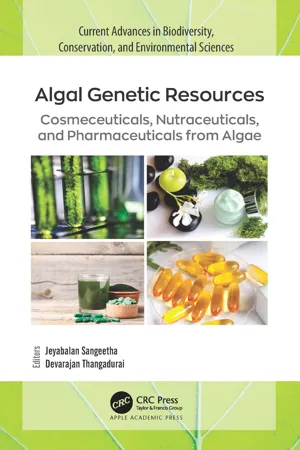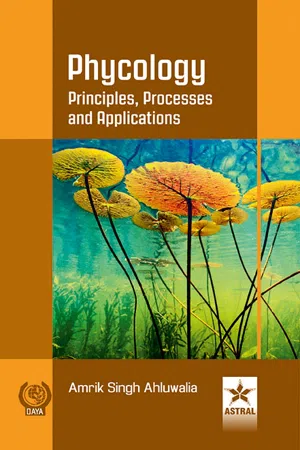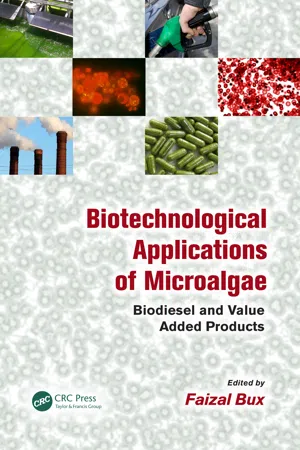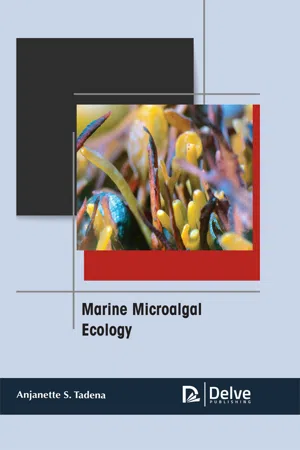Biological Sciences
Algaculture
Algaculture refers to the cultivation and farming of algae for various purposes, such as food, biofuels, and environmental applications. It involves the controlled growth and harvesting of algae in specialized systems, including open ponds and photobioreactors. Algaculture plays a significant role in sustainable resource production and environmental remediation efforts.
Written by Perlego with AI-assistance
Related key terms
1 of 5
5 Key excerpts on "Algaculture"
- eBook - ePub
Algal Genetic Resources
Cosmeceuticals, Nutraceuticals, and Pharmaceuticals from Algae
- Jeyabalan Sangeetha, Devarajan Thangadurai(Authors)
- 2022(Publication Date)
- Apple Academic Press(Publisher)
Hossain et al., 2008 ).Various biomass components alongside lipids can be changed over into unrefined oil. For this, thermo-chemical procedures are employed (Barreiro et al., 2013). Their carbohydrates can also be used in brewing industries to brew alcohol (or in laboratories as well); a few species can even deliver biohydrogen (Radakovits et al., 2010 ).6.1.1 Algaculture
The plethora of applications that algae provide are tempting enough for any researcher to try and figure out a way of harvesting their innate potential. Algaculture or the practice of growing algae at a commercial level is gaining attention because of these prospects.Algaculture employs a potent mixture of traditional land-based agriculture and aquaculture. Elements of both overlap quite considerably, but the activity itself remains to be accorded in its own right. Sunlight, CO2 , and water are the necessities for getting the wheels of the photosynthetic machines up and running but additional requirements, those associated with aquaculture, also need fulfillment, such as water quality assessment, water changes, etc. With the advent and widespread industrial use of bioreactors, microbial cultivation is easier and more practical than ever before.As a result of their capacity to deliver products that cover numerous business sectors, including those of functional food (health-based diet), nutraceuticals, medicines, feed, and fodder, synthetics, and fuels, algae are excellent candidates for being among the most flexible crops (Rosenberg et al., 2008 ).6.1.2 MICRO- AND MACRO-ALGAE
When looking over algae, one needs to recognize two separate groups: the microscopic micro-algae and the macroscopic macro-algae. While macro-algae are essentially what we commonly refer to as seaweeds, microalgae are infinitesimal life-forms, which make up the world’s phytoplankton and contribute to quickly developing populaces of algae in water when provided with the vital supplements such as, but not limited to, nitrogen, and phosphorus. - Ahluwalia, Amrik Singh(Authors)
- 2021(Publication Date)
- Daya Publishing House(Publisher)
Introduction Algae comprises multitude of heterogenous and polyphyletic assemblage; ranging from minute unicells to gigantic kelps. These ubiquitous organisms are found on rocks, soil, trees as well as predominant in water bodies, both marine and fresh water of tropical, temperate and polar regions (Ahluwalia, 1993). Culture of aquatic organisms for their commercialization is known as aquaculture. Sustainable aquaculture includes the judicious use of This ebook is exclusively for this university only. Cannot be resold/distributed. the resources (i.e. algae, fishes etc.) thus ensuring their availability for the present generation as well as preserved for the future. With increasing population, there is an acute pressure on land for the available resources and hence their over exploitation and even depletion. In this context, aquatic resources are being explored as an alternative to sustain the ever increasing number of human race for food. The importance of algae in aquaculture has been well known since ages. The organisms constitute the basic link of the food cycle of aquatic animals (DeSilva and Anderson, 1995). Without a proper appreciation of the role of these autotrophic organisms (algae), the sustained maximum yield of fish cannot be obtained or maintained (Reitan et. al., 1997). Since total global aquacultural production has been rising every year, this industry is projected to grow at the rate of 8% per year for foreseeable future (Tacon, 1998) and hence the importance of algae. Decreasing natural catches and increasing world dependence on the fish as a food source has led to a growing interest in aquaculture. Central to sustainable aquaculture is the need to establish and maintain a food chain to support the animals until they achieve the market size. The annual global aquacultural production of marine algae is currently placed around 6.5 x 10 6 tonnes (Tacon, 1998).- eBook - PDF
Biotechnological Applications of Microalgae
Biodiesel and Value-Added Products
- Faizal Bux(Author)
- 2013(Publication Date)
- CRC Press(Publisher)
77 6 Harvesting of Microalgal Biomass Manjinder Singh, Rekha Shukla, and Keshav Das Biorefining and Carbon Cycling Program College of Engineering The University of Georgia Athens, Georgia 6.1 INTRODUCTION Microalgae have been identified as a potential alternative resource for biofuel production. Significant drawbacks to Algaculture include dilute culture density and the small size of microalgae, which translates into the need to handle large volumes of culture during harvesting. This energy-intensive process is therefore considered a major challenge for the commercial-scale production of algal biofuels. Most of the currently used harvesting techniques have several drawbacks, such as high cost, flocculant toxicity, or nonfeasibility of scale-up, which impact the cost and quality of products. As harvesting cost may itself contribute up to one-third of the biomass pro-duction cost, substantial amounts of research and development initiatives are needed to develop a cost- and energy-effective process for the dewatering of algae. Several factors, such as algae species, ionic strength of culture media, recycling of filtrate, and final products, should be considered when selecting a suitable harvesting tech-nique. Harvesting cost and energy requirements must be reduced by a factor of at least 2 if algal biomass production is to be viable for very low-cost products such as biofuels. There could be considerable cost and energy savings in custom-designed, CONTENTS 6.1 Introduction .................................................................................................... 77 6.2 Harvesting Processes ...................................................................................... 79 6.3 Gravity Sedimentation .................................................................................... 79 6.4 Centrifugation ................................................................................................. - eBook - PDF
- Anjanette S. Tadena(Author)
- 2020(Publication Date)
- Delve Publishing(Publisher)
The above mentioned four benefits would be promoting high nutrient resources utilization for cost-effective cultivation of algae. Lower emissions of GHG would already be shown by pilot-scale algal bioreactors for biofuel production usage, compared to petroleum and other bioenergy benchmark; there would be yet limitations which require to be addressed (Lundquist et al., 2010; Liu et al., 2013). 3.5.2. Algal Cultivation in Wastewater Economic factors affect the trends in algal cultivation. The main aim of Algal cultivation is producing at a very low cost in large amounts of lipids and biomass. There are some factors and parameters that must be kept in mind while designing the processes in algal cultivation. Utilization, Cultivation, and Metabolism of Microalgae 63 The parameters that are well understood are like temperature, pH, carbon source and light intensity. Generally like any other biological wastewater treatment system, the algal waste water pollution process should be operated. The growth of algal can be affected by large variations in pH and temperature. The algal can grow very well with the nutrients found in the waste water. However, the nutrient control can support the production of desirable lipid in the agriculture cultivation, for example, P depletion. The liquid content can also be improved with the help of other components silicon or trace metals. In order to correctly monitor the proper autotrophic cultivation and pH control the inorganic carbon concentration plays an important role in fulfilling this. There are certain irregular waste streams for which salinity may be needed to be considered (e.g., desalination concentrate). There is large role of salinity in algal cultivation. Additional there is a direct impact of reactors of algae cultivation on the cultivation cost. There is an extensive study ongoing for tradeoff between liquid content, Algae purity, and cost. - eBook - PDF
Biofertilizers
Study and Impact
- Mohd Imran Ahamed, Rajender Boddula, Mashallah Rezakazemi(Authors)
- 2021(Publication Date)
- Wiley-Scrivener(Publisher)
Moreover, recent advancements to exploit, develop, and manufacture novel algal biofertilizers with innovative strategies for sustainable agriculture are also discussed in the chapter. Particular emphasis is given on algal strains to produce biofertilizers, the methods to obtain algal biomass, and strategies for subsequent use for plant growth. Finally, processes and technologies to cultivate algae and manufacture algal biofertilizers on a mass scale are discussed. Keywords: Algae, algal fertilizers, biofertilizers, recycling, biostimulant, sustainable agriculture *Corresponding author: [email protected] † Corresponding author: [email protected] 608 Biofertilizers 22.1 Introduction Algae are photosynthetic microorganisms that are used as biofertilizers in the field of crop cultivation [1, 2]. The biomass obtained from algae holds nutrients and organic substances in larger quantities and promotes the slow release of nutrients from fertilizers and soil and increases the absorp- tion of nutrients from fertilizers [3]. Products obtained from organic material are biostimulants and enhance the development and growth of many crops grown under normal conditions or stress. Biofertilizers con- tain living microorganisms or natural substances capable of increasing the nutrient status of soil and hence increase plant growth. Both characteris- tics of microalgae improve agricultural sustainability and are increasing the intrigue of agrochemical industries and farmers in microalgae [4, 5]. An increase in the crop yield for sustainable agriculture depends on inorganic fertilizers. However, the excessive use of inorganic fertilizers is a menace not only for the environment but also for human beings. Thus, there is a need to explore microorganisms such as microalgae cyanobac- teria and mycorrhizal fungi capable of symbiosis with plants to produce biofertilizers [6, 7].
Index pages curate the most relevant extracts from our library of academic textbooks. They’ve been created using an in-house natural language model (NLM), each adding context and meaning to key research topics.




